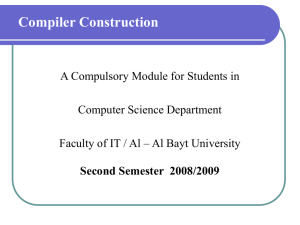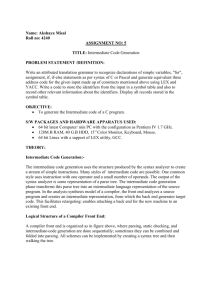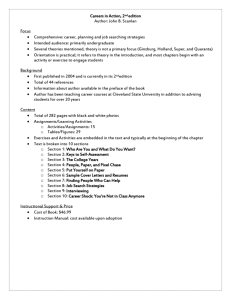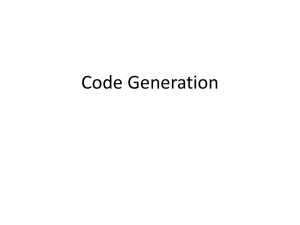Choosing an Intermediate Representation - FACOM
advertisement
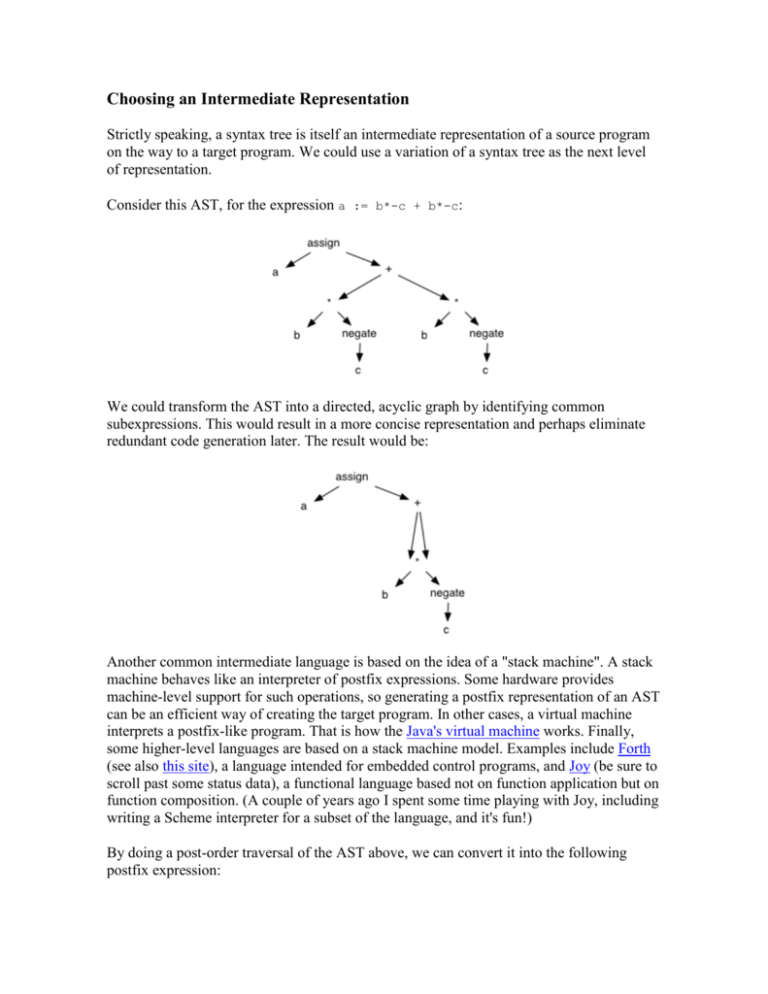
Choosing an Intermediate Representation Strictly speaking, a syntax tree is itself an intermediate representation of a source program on the way to a target program. We could use a variation of a syntax tree as the next level of representation. Consider this AST, for the expression a := b*-c + b*-c: We could transform the AST into a directed, acyclic graph by identifying common subexpressions. This would result in a more concise representation and perhaps eliminate redundant code generation later. The result would be: Another common intermediate language is based on the idea of a "stack machine". A stack machine behaves like an interpreter of postfix expressions. Some hardware provides machine-level support for such operations, so generating a postfix representation of an AST can be an efficient way of creating the target program. In other cases, a virtual machine interprets a postfix-like program. That is how the Java's virtual machine works. Finally, some higher-level languages are based on a stack machine model. Examples include Forth (see also this site), a language intended for embedded control programs, and Joy (be sure to scroll past some status data), a functional language based not on function application but on function composition. (A couple of years ago I spent some time playing with Joy, including writing a Scheme interpreter for a subset of the language, and it's fun!) By doing a post-order traversal of the AST above, we can convert it into the following postfix expression: a b c - * b c - * + := In Joy, I could use the dup(licate) primitive to directly represent the equivalent DAG: a b c - * dup + := A postfix representation converts a tree into a linear form. Note that the postfix expression does not represent the edges of the tree directly; they are implicit in the order of items on the stack and the number of arguments expected by the operators on the stack. (Converting from a tree to a postfix expression and back reminds me of a wonderful technique that I used to teach in my Data Structures course, in which one can recover a tree and its edges even without any information about the items -- if one but has two linear representations -- say, in postfix and infix. Algorithms used to do intermediate transformations in compilers use the same idea!) Syntax trees can be represented in a compiler in many ways. In both, a node is represented with a record. In one, each record contains pointers to the records of its children. This is the sort of representation that our ac compiler uses. In another, each node is a record in an array of records. Terminal nodes use all of their slots to record information about the item. Non-terminals use one or more of their slots to hold the integer indices of their children. For example, we might represent our familiar AST as follows: (And this reminds me of techniques we used when I first learned to program in Fortran, which did not have dynamic memory allocation. These techniques remain in use because they result in efficient implementations.) Three-Address Code We can do better by choosing an intermediate representation that moves us closer to the level of the machine, without tying us to the details of any particular machine. So, after manipulating the abstract syntax tree of a program, and perhaps a postfix representation of it, we will transform the program into a three-address code representation. Statements in three-address code are patterned on the general form x := y op z where op is primitive operation, y and z are its argument, and x is the location in which to store the result. The name of the representation derives from the fact that each expression uses at most three objects or locations. Because all expressions in three-address code contain exactly one operator, we must decompose compound expressions into sequences of simpler expressions, perhaps using temporary variables to hold the intermediate results. For example, we might represent the expression x + y * z as the following three-code program: t1 := y * z t2 := x + t1 We create the temporary names t1 and t2 for locations to hold intermediate results. We can represent the more complicated AST and DAG above using the following threeaddress code programs: t1 t2 t3 t4 t5 a := := := := := := * b * t2 + t5 t1 t2 t3 a := - c := b * t1 := t2 + t2 := t3 b c t1 c t3 t4 Notice that we have already adapted the general form of three-address code in two ways. First, some operators take only one argument and so need only two addresses. Second, some assignments merely copy a known value to another location, and such expressions need neither third address nor an operator beyond the assignment. You may also notice that we have used a temporary name for the whole expression, even though we immediately copy the value into the user-defined variable a. The optimizer or code generator may well eliminate this extra step later, but the extra temporary's presence enables certain other algorithms to be applied to the representation. At least two features of three-address code make it a good representation for optimization and code generation. First, it forces the compiler to unravel compound expressions and flow-of-control operations into sequences of simpler expressions. Second, its use of names for intermediate values means that expressions can more easily be rearranged. A three-address code program represents the nodes and edges that appear in an AST, but adds the use of names for internal nodes. A three-address code program linearizes an AST in the way a postfix expression does, but represents the edges explicitly via its temporaries. Designing a Three-Address Code Language As you can see, three-address code resembles assembly language in its level of expression. The expressiveness of a three-address code language depends on the number and kind of statements allowed. In particular, any useful three-address code language will likely have: binary assignments of the base form x := y op z. The language must define a certain set of arithmetic and boolean operators. unary assignments of the simpler form x := op y. Unary operators include not only arithmetic and boolean operators but also shift and type conversion operators. copy assignments of the even simpler form x := y. To support flow of control, it will likely have: unconditional jumps of the form goto x, where x is a label in the program. conditional jumps of the more general form if x op y goto z, where op is a boolean operator and z is a label in the program. a set of statements for higher-level transfers of control such as procedure calls. This set might contain the forms o param x where x is the location of a parameter, o call x y, where x is the location of a code segment to execute (the procedure body) and y is the number of arguments to the procedure, and o return x, where x is the location of the value returned to the calling code. Finally, in order to represent higher-level data types such as arrays and pointers, it may have: indexed assignments of the forms x := y[z] and x[y] := z, where [] is the subscript operator. address assignments of the forms x := &y and x := *y, where & is a unary operator that returns the address of its argument and * is a unary operator that returns the value at the address specified by its argument. A three-address code language for representing Oberon-0 programs would require all of these but the address assignments, whereas a language for representing C programs would require address assignments, too. The design of a three-address code -- and especially its set of unary and binary operators -has a large effect on the resulting code generator. As mentioned above, the intermediate language must be rich enough to implement the semantics of the source language. Beyond that, we must strike a balance between a small-enough language, which is easy to implement and retarget, and a too-small language, which leads to longer three-address code programs. The longer the resulting representation, the harder the optimizer and code generator must work harder to generate an efficient target program. Generating Three-Address Code So, how can we generate a representation in three-address code? We will use the same technique we used to process the abstract syntax tree in earlier stages of the compiler: walk the tree using structural recursion! For each of type of expression in the AST, write the code that generates an equivalent three-address code. Some of the issues we will have to consider include: how to represent three-address code instructions, how to generate and use temporaries, how to generate and use labels, and how to implement higher-order structures. Generating Three-Address Code Recall that a three-address code language will likely have binary assignments, unary assignments, copy assignments, unconditional jumps, conditional jumps, a set of statements for higher-level transfers of control such as procedure calls, indexed assignments, and address assignments. To generate a three-address code representation of an AST, we will use the same technique we used to create and process the abstract syntax tree in earlier stages of the compiler: walking the tree using structural recursion. For each of type of expression in the AST, write the code that generates an equivalent three-address code. In the compilers world, this is often referred to as syntax-directed translation. Each expression E on the lefthand side of a grammar rule will be computed into a new temporary variable ti. The representation generated for E will consist of two parts: E.place, which holds the name of the temporary ti that will hold the value of E, and E.code, which the holds the three-address code statements that implement E. Generating three-address code requires using many temporary variables. The code generator will need a procedure such as makeNewTemp() to create a new, unique temporary variable name each time it is called. For simplicity, we'll assume that we have such a procedure and that it generates the sequence t1, t2, t3, .... Also for simplicity, we will use a unique identifier for each temporary. A more efficient compiler could use a small pool of unique identifiers, reusing the same name multiple times in different scopes. The code generator will need to emit code in three-address form. For simplicity, let's assume that we have a procedure emitCode() that works like Java's OutputStream.println method: it takes a single string, perhaps concatenated from many parts, and writes it followed by a new line character. In our discussion, we will use emitCode() to generate a string that we can store in an expression's code field, though in practice this procedure would typically write on an output stream, that may be bound to a file. When writing your compiler, you can implement makeNewTemp() and emitCode() to behave in just these ways, and then use them! Try Your Hand at Generating Three-Address Code ... Suppose that we have the following simple grammar: S E E E E E -> -> -> -> -> -> id := E E1 + E2 E1 * E2 - E1 ( E1 ) id Here is the semantic action for the first arm of the grammar: S -> id := E -----------S.code := [ E.code ] emitCode( id.place " := " E.place ) The [ E.code ] means to make a recursive call to compute the three-address code for E and place it immediately before the code generated by the call to emitCode(). Notice that this grammar rule is a special case, as its lefthand symbol does not have a temporary variable associated with its value. Now it's your turn... Use the procedures makeNewTemp() and emitCode() to write the semantic actions for a three-address code generator. Structural recursion does most of the work. These semantic actions simply package the code built by the recursive calls with the newly-generated statement, if any, in the correct order. Here is a possible solution. E -> E1 + E2 -----------E.place := makeNewTemp() E.code := [ E1.code ] [ E2.code ] emitCode( E.place " := " E1.place " + " E2.place ) E -> E1 * E2 -----------E.place := makeNewTemp() E.code := [ E1.code ] [ E2.code ] emitCode( E.place " := " E1.place " * " E2.place ) E -> - E1 --------E.place := makeNewTemp() E.code := [ E1.code ] emitCode( E.place " := negate " E1.place ) E -> ( E1 ) ----------E.place := E1.place E.code := E1.code E -> id ------E.place := id.place E.code := "" When we implement this code, a programmer-defined identifier is replaced by a pointer to a symbol table entry for the name. Processing Higher-Level Control Structures Most source languages have high-level control structures such as if..then..else.. and for..to..do... Three-address code can represent such statements using code labels and jumps. Consider the simple while statement: S -> while E do S1 First of all, we need to make a decision about the semantics of boolean values in the little language. What values of E count as true, and which count as false? For simplicity, let's define 0 as false and everything else as true. Second, we need to create a new procedure in our code generator: a procedure that produces unique labels for use in the generated code. Unlike the case of temporary variables, we cannot reuse labels multiple times, as they all exist in the same namespace. So they really must be unique. Let's assume the presence of a procedure named makeNewLabel() that generates the sequence of unique labels L1, L2, L3, .... Now we are ready to generate three-address code for the while statement. This translation resembles the one that you make when implementing a loop in assembly language. We need to generate code bodies for the constituent expression and statement and then use jumps to ensure that the three-address code has the same semantics as the while statement. Here is a picture of what the generated code will look like: So, we need to generate two labels and make recursive calls to generate code for E and S1. The semantic action for the while statement would look something like this: S -> while E do S1 -----------------L1 = makeNewLabel() L2 = makeNewLabel() S.code := emitCode( L1 ": [ E.code ] emitCode( "if " [ S1.code ] emitCode( "goto emitCode( L2 ": " ) E.place " = 0 goto " L2 ) " L1 ) " ) Why don't you try your hand at a simple control structure. Let's add to our little language an if statement: S -> if E1 = E2 then S1 Write the semantic action to generate three-address code for this statement. This turns out to be quite similar to the while statement. Here is a picture of what the generated code will look like: The semantic action itself will look something like this: S -> if E1 = E2 then S1 ----------------------L3 = makeNewLabel() L4 = makeNewLabel() S.code := [ E1.code ] [ E2.code ] emitCode( "if " emitCode( "goto emitCode( L3 ": [ S1.code ] emitCode( L4 ": E1.place " = " E1.place " goto " L3 ) " L4 ) " ) " ) How does adding an else clause complicated code generation? Some Implementation Issues A three-address statement is an abstraction that the compiler writer must implement in code. In practice, each statement will be a record with fields for its parts. What might each three-address code statement look like? There are at least two options. We could represent the record as a quadruple, record with four fields: the operator, the left operand, the right operand, and the result. Unary operators can leave the right operand slot empty. Some operators won't need to use the result slot, either; for example, param needs to identify only a single argument to a procedure. Finally, jump instructions don't have results, but they do have target labels; the label can be stored in the result slot. (If you implement these statements using objects or variable-length records, then these conventions become unnecessary.) Consider the three-address code for our old friend, the expression a := b*-c + b*-c: As mentioned earlier, the slots that refer to programmer-defined names can be replaced with pointers to the corresponding symbol table entries. Notice that the use of quadruples create a kind of duplication. Each statement has a result, which stored in a temporary location, the sequencing of which matches exactly the sequence of the statements themselves. We can eliminate this representation of the temporaries by storing in the corresponding argument slot the number of the instruction that computes it. The is an implementation of three-address code in a real triple. Here is what a triple representation would look like for our example: Note that the record number (0 through 4) now stands in place of the five temporaries (t1 through t5) and eliminates the need for a result field. Using triples creates a new wrinkle for statements such as a[i] := x, because it is really a three-way operation: computing the target slot in the array, and then assigning to it. Such a statement requires two triples: There are some interesting trade-offs between these two representations, and by using our symbol table (!) we find a nice balance using an alternative known as indirect triples. Let's leave that as material beyond the scope of the course. Feel free to read up on the idea, or to ask. There is one other issue that can arise. When the compiler generates code for a boolean expression or a conditional statement, it may not yet know where the target of a jump is. The result is a label with no corresponding code in the target program. This can also occur when the compiler generates code "out of order", say, by generating code for localk chunks of the AST independently and then stitching the pieces together at the end. One solution is to generate code in two passes, a first to generate the framework of the target program and a second to compute the jumps and labels. Another approach makes only a single pass over the whole program. When the compiler generates a branch whose jump target is undefined, it adds the statement to a list o "jumps to be completed". As soon as the correct label is known the compiler fills in the slot and removes the statement from the to-do list. This technique is known as backpatching. Again, let's leave this idea as beyond the scope of the course. Feel free to read up on the idea, or to ask. Note that for simple languages this problem may not arise.
